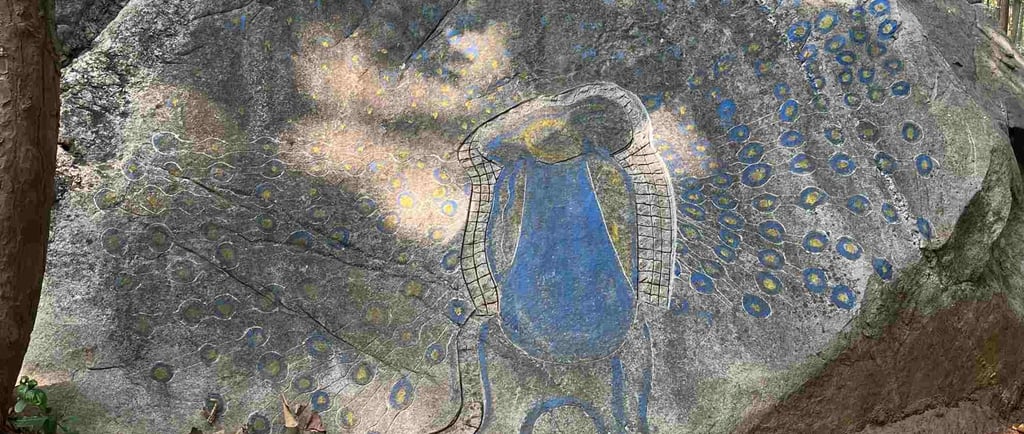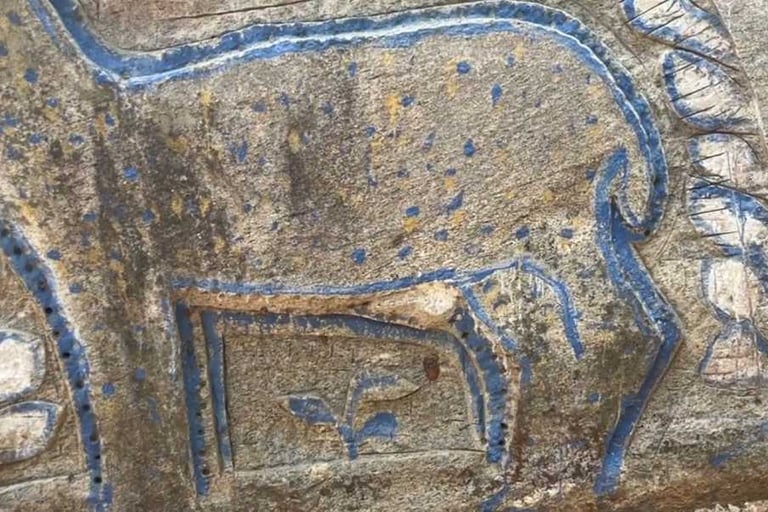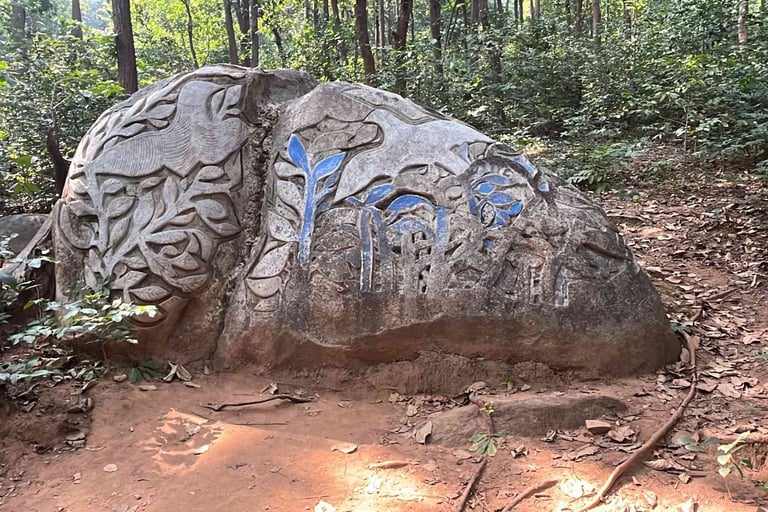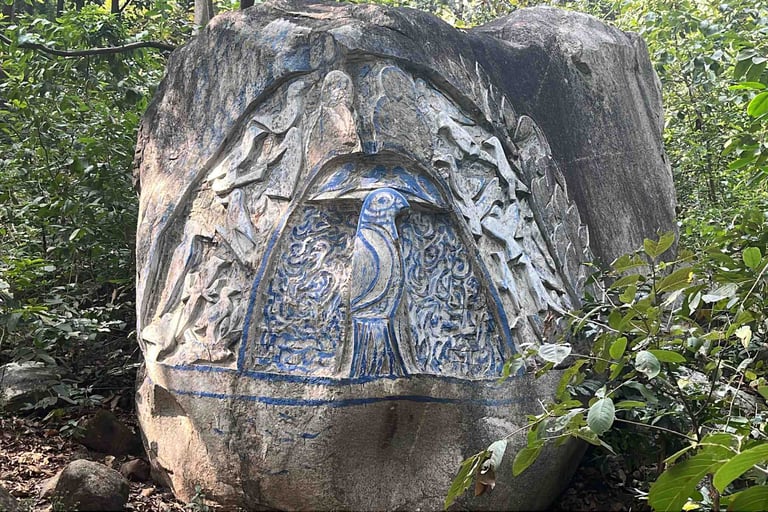Pakhi Pahar Purulia Travel Guide: Bird Hill, Rock Art & Ayodhya Hills Gems
Discover Pakhi Pahar in Purulia — Bird Hill’s stunning rock art, local guide tips, Ayodhya Hills hidden gems, and a unique travel experience
PURULIAWEST BENGAL
Arghyaraj Basu
7/3/20256 min read


There are some places you visit for the checklist, and then there are places that cling to your heart long after you’ve left — Pakhi Pahar is firmly in the second category for me.
I first heard about this place through a friend who couldn’t stop raving about “birds carved on a mountain.” Honestly, I brushed it off. But last month, curiosity got the better of me, and I found myself winding through the quiet roads of Purulia’s Ayodhya Hills, on my way to see what I thought would be just another viewpoint. I couldn’t have been more wrong.
A Hill Turned Into Art
The first glimpse of Pakhi Pahar (or Bird Hill) made me pause. There it stood a giant cliff face called Murraburru rising from the gentle hills, its sheer surface alive with birds seemingly frozen mid-flight.
Up close, the details take your breath away. These are not just carvings they’re monumental wingspans, some stretching over 120 feet, capturing the grace of birds in a way that makes you feel they could take off any second. I learned from a local guide that this was the life’s work of Shri Chitta Dey, an artist whose passion literally moved mountains. Along with his team, he carved 65 different birds into this cliff each one a tribute to freedom, harmony, and our fragile connection with nature.
Standing there, I felt oddly small yet deeply connected to something vast like I was listening to a silent story sung by stone birds and whispered by the wind brushing past the hills.
More Than Just a View
What surprised me most is that Pakhi Pahar isn’t just about standing and staring it’s an entire experience if you’re willing to lean in.
When I arrived, a local woman approached me, introducing herself as a travel guide. She offered to walk me around and share stories behind the giant carvings all for just Rs. 50. It felt only fair and honestly, worth every rupee.
With a quiet smile, she led me along narrow trails skirting the base of the cliff, pointing out hidden details I would have missed like a tiny bird etched between two giants, or how the sunlight brings different birds to life at different hours. She also pointed out a few sections where outlines of birds were clearly visible, but the carvings were only half-done wings paused mid-spread, beaks only roughly shaped from the stone.
She explained that while Shri Chitta Dey’s vision was to cover the entire cliff with birds, some parts remain unfinished due to a shortage of funds and resources. It was a humbling reminder that monumental dreams often battle real-world limitations. Yet, seeing those unfinished forms somehow made it feel even more alive like the hill itself is still dreaming, waiting for more hands and hearts to keep the vision soaring.
I met a group of rock climbers too they had traveled from Kolkata just for the thrill of scaling Murraburru’s rugged face. I’m not much of a climber, so after my guided tour, I stuck to gentler adventures a short nature walks around the base, camera in hand, trying (and mostly failing) to capture the impossible play of light and shadow on the carvings.
I swear, every angle revealed something new the curve of a wing, the stern gaze of a stone eagle, or just the sheer scale that humbles you. I ended up spending hours there, just sitting under a tree, letting the calm of the Ayodhya Hills soak in.
Wandering Through Purulia’s Secrets
I couldn’t resist exploring more once I was here. If you ever visit Pakhi Pahar, don’t stop at the hill the Ayodhya Hills region is full of hidden gems that feel delightfully untouched by the usual tourist noise.
I stopped by Pardi Dam, where the reflection of the sky made the water look like a polished mirror. Next, I trekked to Bamni Falls and Turga Falls nothing fancy, just the raw joy of hearing water crash on rocks and feeling the spray on my face.
But the highlight, apart from Pakhi Pahar, was Charida Village, known as Mukhosh Gram. It’s called that for a reason step into this village and you’re surrounded by the craft of Chhau mask makers. These masks are more than decoration they’re alive with stories of warriors and gods, danced into being through the region’s famous Chhau dance. I even saw an impromptu performance, the dancers moving with such fierce grace that I forgot to blink.
The Journey is Part of the Magic
Getting here wasn’t hard, but it felt like an adventure in itself. I took a train to Purulia Railway Station, then a shared jeep through winding roads flanked by rolling hills and sleepy tribal hamlets. I will prefer book a rented car from Purulia and visit Pakhi Pahar.
No matter how you arrive, the approach to Ayodhya Hills is something you should take slow stop for tea at roadside stalls, chat with villagers if you can, watch the landscape shift from plains to rugged green. It’s worth every extra minute.
A Silent Promise
Before I left Pakhi Pahar, I sat one last time beneath the towering stone wings. An elderly local, who’d been quietly sweeping the trail, sat beside me. He told me how Shri Chitta Dey’s dream wasn’t just about carving birds it was about reminding us to protect the world we share with them.
It struck me that Pakhi Pahar is more than a tourist spot it’s a silent promise. A promise that humans can create something beautiful with nature instead of just taking from it.
If you ever crave an experience that feels raw, real, and quietly magical, pack your bags for Purulia. Stand beneath the watchful gaze of stone birds on Pakhi Pahar, let the hills calm your restless mind, and carry a bit of that freedom back with you.
FAQs
1. What is Pakhi Pahar?
Pakhi Pahar (meaning Bird Hill) is an 800-foot hill in the Ajodhya Hills of Purulia, West Bengal, famous for its unique rock sculptures of birds carved directly into the hillside by artist Chitta Dey and his team.
2. Where is Pakhi Pahar located?
Pakhi Pahar is near Charida village and Baghmundi in the Ajodhya Hills region of Purulia district, West Bengal. It’s about 30–35 km from Purulia town.
3. Why is Pakhi Pahar famous?
It’s famous for its open-air bird carvings over 60–65 birds etched into the rock face. It’s a rare example of large-scale community rock art in India, blending nature and creative conservation.
4. Who created Pakhi Pahar?
The concept and carvings were initiated by renowned artist Chitta Dey in the early 1990s. Local villagers and art students helped bring his vision to life.
5. What can visitors do at Pakhi Pahar?
See the bird carvings up close
Enjoy light trekking and rock climbing
Photograph the stunning hill and surroundings
Meet local artists and villagers in Charida
Explore nearby waterfalls, dams, and forest trails
6. Is there an entry fee for Pakhi Pahar?
No, there is no official entry fee to visit Pakhi Pahar itself. However, you may hire local guides for a small fee, which supports the community.
7. When is the best time to visit Pakhi Pahar?
The ideal season is November to March, when the weather is pleasant for trekking. The monsoon (July–September) is also beautiful if you like greenery but trails can be slippery.
8. How do I reach Pakhi Pahar?
By Train: Nearest station – Purulia Junction. Hire a car or take a local bus to Baghmundi/Charida.
By Road: From Kolkata (~320 km) via NH2 or SH5.
By Air: Nearest airport – Ranchi (approx. 87 km).
9. Are there any places to stay near Pakhi Pahar?
Yes, homestays and eco-resorts are popular nearby:
Charida village homestays (known for Chhau masks)
Bon Polashi Eco Huts
Ajodhya Hill Tourism resorts
10. What else can I see near Pakhi Pahar?
Combine your visit with:
Charida village (famous for Chhau mask artisans)
Bamni Falls
Marble Lake
Upper & Lower Dam
Trekking routes in Ajodhya Hills
11. Is Pakhi Pahar safe for solo travelers?
Yes, it’s generally safe, but it’s best to go with a local guide, especially if trekking. Avoid late evenings due to forested areas.
12. What should I carry for the trip?
Good trekking shoes
Water, snacks
Sun protection
Camera or binoculars
Cash (ATMs are far)
You can also check out real traveler reviews on TripAdvisor to plan your visit to Pakhi Pahar.







